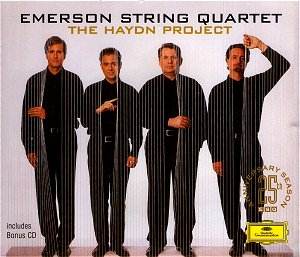 Composer: Joseph HAYDN (1732-1809)
Composer: Joseph HAYDN (1732-1809)
Works:
Performers: Emerson Quartet
Eugene Drucker, violin
Philip Setzer, violin
Lawrence Dutton, viola
David Finckel, cello
Recording: LeFrak Concert Hall, Queens College, NY, 2000-01
Label: Deutsche Grammophon
1. String Quartet No. 23 in F minor, Op. 20/5, H. 3/35
Joseph Haydn’s string quartets form an essential pillar of the chamber music repertoire, often regarded as the very cradle of the genre. The Emerson Quartet’s “Haydn Project,” celebrating their 25th anniversary, assembles seven of Haydn’s most compelling quartets, offering a vibrant exploration of the composer’s evolution from the intricate counterpoint of his early works to the lyrical breadth of his later creations. This collection not only showcases the Emerson Quartet’s technical prowess but also their deep interpretative insight into Haydn’s unique blend of humor, depth, and structural innovation.
The performances are marked by an infectious energy that reflects the Emerson’s profound understanding of Haydn’s stylistic nuances. In the opening movement of String Quartet No. 23 in F minor, Op. 20/5, one is immediately struck by the quartet’s ability to navigate the harmonic complexities with precision, bringing forth the work’s underlying tension. The two-part fugue in the final movement is not merely a display of technical skill but a vivid dialogue among the instruments, characterized by a meticulous balance that invites the listener to appreciate the intricate interplay of voices. The Emerson Quartet’s dynamic contrasts are particularly noteworthy; they imbue the Allegro movement with a buoyancy that feels both spontaneous and carefully calibrated.
Haydn’s String Quartet No. 30 in E flat major, known as the “Joke,” is a delightful testament to the composer’s wit. The Emerson’s interpretation captures the playful spirit inherent in the work, particularly in the final movement, where the deceptive cadences elicit laughter and surprise. Here, their deft use of phrasing and tempo shifts enhances the sense of joviality, allowing the music’s humor to resonate authentically. This attention to character continues throughout the recording, exemplifying their ability to render the subtleties of Haydn’s musical language with clarity and vibrancy.
The technical execution of the Emerson Quartet is nothing short of exemplary. Their unified sound and cohesive phrasing allow for a seamless blend of timbres, with each instrument clearly delineated in the sonic landscape. The recording quality deserves particular commendation; the intimate soundscape created by the engineering team effectively places the listener within the drawing room context that Philip Setzer references in the liner notes. The spatial separation of instruments is striking, especially in a headphone listening experience where the nuances of articulation and dynamics come to the forefront, enhancing one’s appreciation of Haydn’s intricate textures.
This collection stands in notable contrast to other recordings of Haydn’s quartets, such as those by the Hagen Quartet or the Alban Berg Quartet, which often emphasize a more cerebral interpretation. The Emerson Quartet, however, thrives on emotional immediacy and expressive vitality, making it a refreshing addition to the discography. Their interpretation of String Quartet No. 61 in D minor, known as the “Fifths,” showcases this approach, with a gripping intensity that draws the listener into the work’s dramatic narrative.
The Emerson Quartet’s “Haydn Project” emerges as a significant contribution to the chamber music canon, characterized by joyful exuberance and profound understanding of Haydn’s artistry. This recording not only celebrates the quartet’s artistic journey but also invites listeners to engage with Haydn’s music in a new light. As a testament to the ensemble’s passionate commitment to the music, this collection is a gem that merits a prominent place in any serious collection of classical recordings. The hope for further explorations of Haydn’s quartets by the Emerson Quartet feels not only justified but also tantalizingly necessary.



